Inquivix HQ
1-903, 18 Eonju-ro 146-gil,
Gangnam-gu, Seoul, Korea
06057
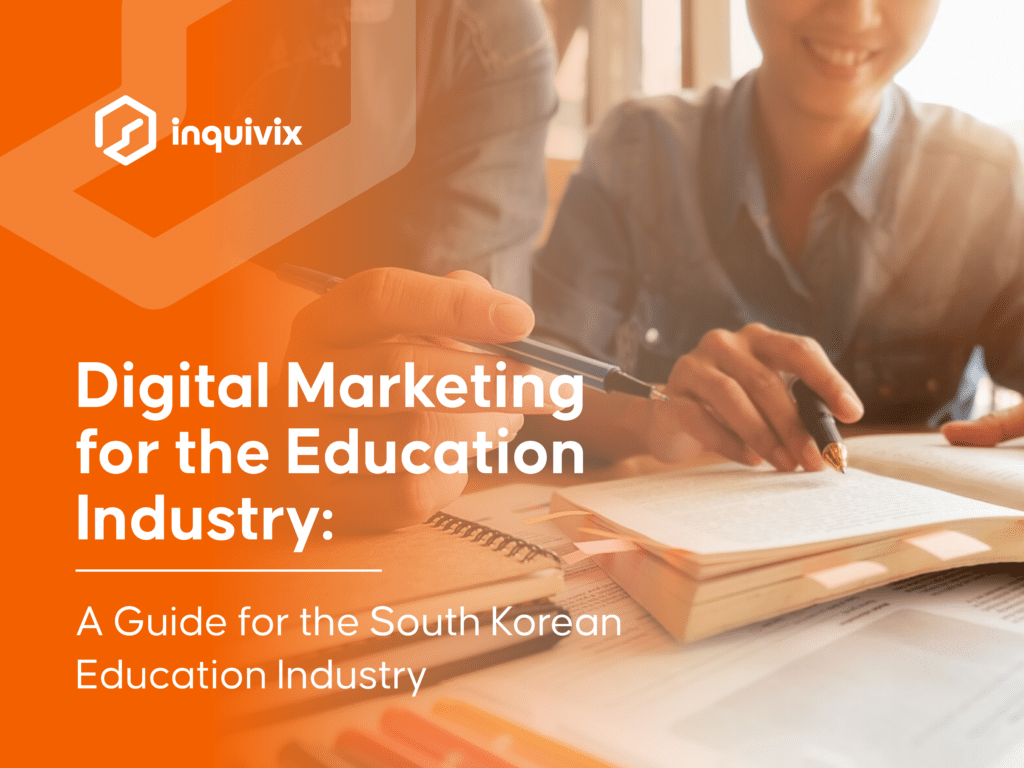
In our increasingly digital world, no industry remains untouched by the transformative power of digital marketing. Among these, the education sector stands out, particularly in tech-fueled South Korea, where an intense learning culture meets a population adept at all things digital. Digital marketing has become a game-changer here, providing a vital bridge between educational institutions and their audiences, including students, parents, and educators. It is no longer a choice but a necessity for the South Korean education industry to harness digital marketing strategies to keep pace with change and maintain relevance. This blog post serves as a comprehensive guide, demystifying how digital marketing is reshaping South Korea’s education sector. We delve into why these cutting-edge strategies are vital and explore practical measures for effective implementation.
South Korean Education System
Understanding the structure of the South Korean education system is crucial to grasping the opportunities and challenges in implementing strategic digital marketing within it. The system is structured and diverse, catering to a variety of learning paths from elementary to tertiary levels and even vocational education. It is organized into a single-ladder 6-3-3-4 system, which breaks down into six years of elementary school, three years each of middle and high school, and four years at university. Equality is a key aspect of this system, ensuring that all students receive education based on their abilities, regardless of social standing.

Elementary and Secondary Education
The first nine years, covering elementary and middle school, are mandatory. The system’s continuous evolution began in 1950 when compulsory elementary education was introduced. The subsequent 30 years witnessed a phased progression until compulsory middle school education came into effect in 1985, culminating in nationwide implementation by 2004.
After middle school, students transition into three years of high school, provided they have either graduated middle school or passed a qualifying examination. High schools offer a diverse range of courses, with options to follow general education, opt for vocational instruction, or attend schools for gifted students and special-purpose high schools specializing in subjects like science, arts, or physical education. There are also autonomous high schools that enjoy more freedom in their administrative operations and curriculum design. Even though high school education is not compulsory, it has an impressive 99.7% enrollment rate.
Higher Education
On the tertiary level, education is open to all who have obtained a high school diploma or equivalent credentials. Admissions into colleges depend significantly on students’ College Scholastic Ability Test scores, along with other considerations such as school records. The landscape of higher education in South Korea is diverse and includes colleges, junior colleges, colleges of education for elementary teachers, and online colleges, among others.
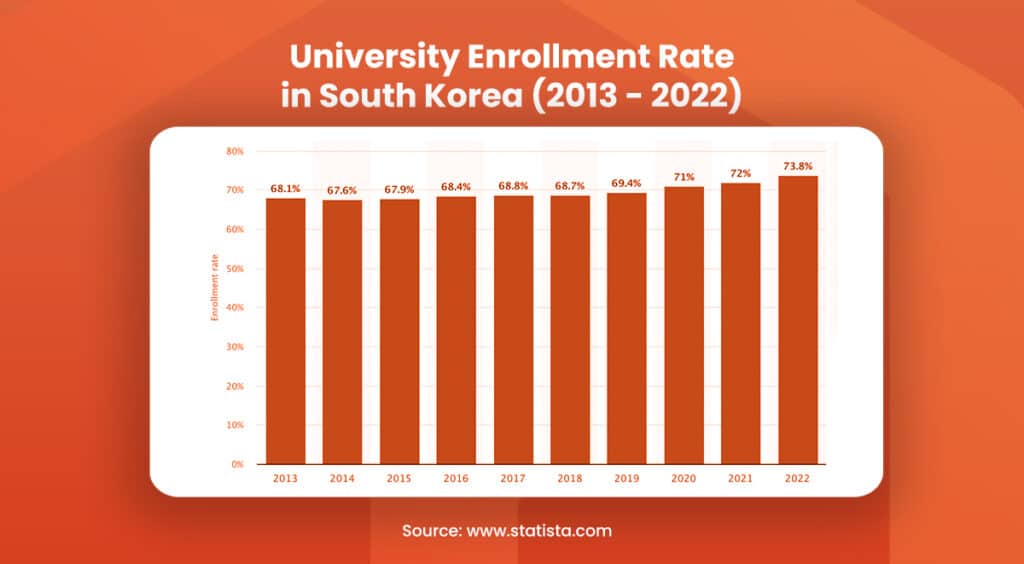
The growth of higher education in South Korea is remarkable. Prior to the 1980s, the enrollment rate in higher education institutions was below 10%. Fast forward to 2019, the rate skyrocketed to 67.8%. Moreover, out of 430 higher education establishments in 2019, a staggering 372 were private, constituting 86.5%.
Vocational Education
Vocational education plays a significant role in the South Korean education system, with its initiation at the upper-secondary level. The majority of vocational training is offered in specialized vocational high schools, including Meister high School, which provides industrial demand-driven courses. Several general high schools also incorporate vocational education programs as part of their curriculum. As of April 2020 vocational high schools in Korea make up 24.3% of all high schools, capturing 18.5% of total high school enrollment.
Why Does the Education Sector Need Digital Marketing?
In an era where technology plays a crucial role in every facet of life, digital marketing not only helps businesses thrive but is equally essential for sectors like education. Let’s delve into understanding why the education sector, particularly in South Korea, can immensely benefit from effective digital marketing strategies.
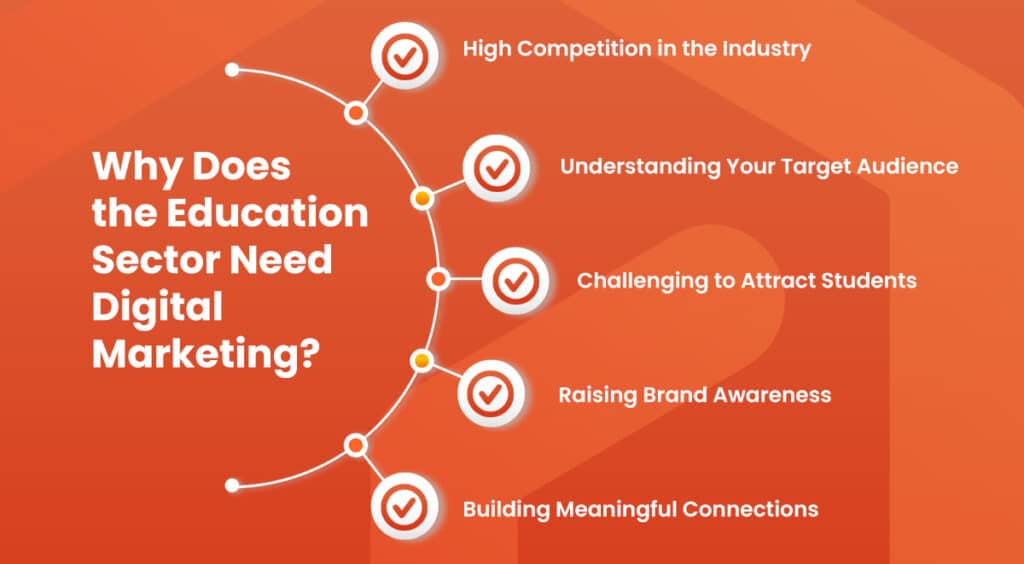
High Competition in the Industry
The South Korean education industry is known to be highly competitive. With many public and private institutions vying for the attention of students and parents, standing out from the crowd can seem challenging. This is where digital marketing steps in. A well-strategized marketing campaign can significantly help an institution differentiate itself, highlight its unique offerings, and engage more effectively with potential students.
Understanding Your Target Audience
Knowing and understanding your target audience is paramount in any marketing strategy. In the education sector, this audience primarily includes students and their parents. Digital marketing tools and analytics offer valuable insights into the behaviors, preferences, and needs of these key decision-makers. This data-driven understanding allows institutions to tailor their offerings and communication, fostering a better connection with their audience.
Challenging to Attract Students
Attracting students, especially in a competitive space like South Korea’s education industry, is a considerable challenge. Digital marketing helps overcome this hurdle by expanding an institution’s reach beyond traditional boundaries. Through online campaigns, social media, and search engine optimization (SEO), institutions can attract and engage with prospective students on platforms they frequently use.
Raising Brand Awareness
Awareness of an institution’s brand, values, and offerings is crucial to attracting and retaining students. Digital marketing methods, such as social media marketing, are instrumental in enhancing visibility and awareness. These strategies not only promote the institution’s educational programs but also showcase its achievements, values, and unique selling propositions.
Building Meaningful Connections
Last but not least, digital marketing opens the door to building meaningful and lasting connections. Through personalized email marketing, engaging social media content, or interactive webinars, institutions can build and foster relationships with students and parents. This not only enhances the student experience but also encourages loyalty and word-of-mouth referrals, which are vital in an industry where personal experiences and recommendations carry significant weight.
Top 8 Korean Digital Marketing Strategies for the Education Industry
In the vibrant South Korean educational landscape, institutions must continually adapt and innovate to be seen and heard. Here are some effective digital marketing strategies that educational institutions can leverage to enhance their reach and impact.
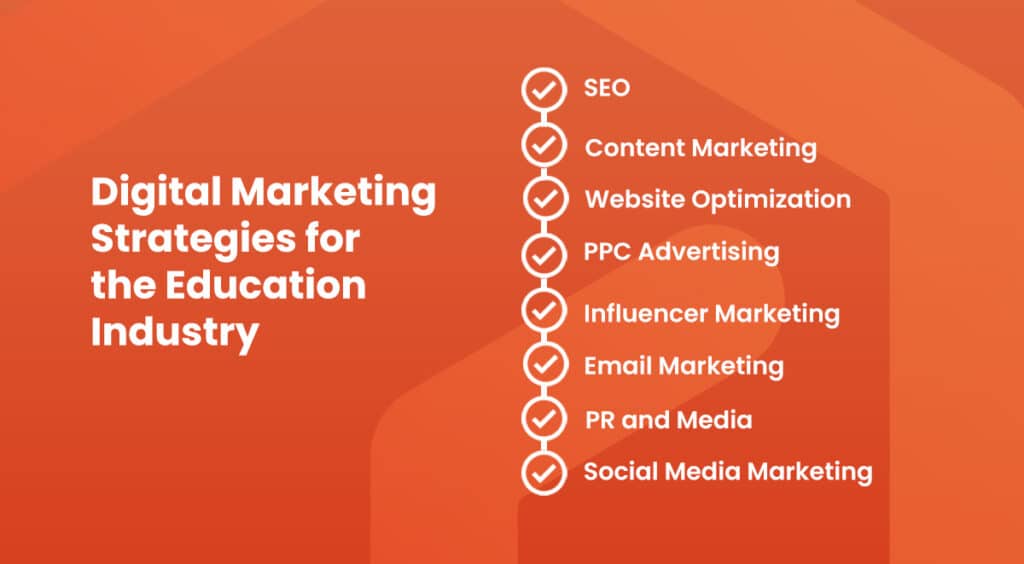
#1 Search Engine Optimization (SEO)
In the education industry, particularly in a digitally-savvy nation like South Korea, Search Engine Optimization (SEO) is an indispensable strategy to enhance online visibility and draw organic traffic to your institution’s website. The first step is conducting thorough keyword research to identify common search terms your target audience uses that resonate with your institution and its offerings. Implementing technical SEO principles, such as optimizing the website structure for user-friendly navigation, speeding up load times, and ensuring mobile responsiveness, further improves search engine rankings.
Building a network of authoritative backlinks is another essential SEO strategy, lending credibility to your site and enhancing its domain authority. On-page SEO practices, like optimizing website content and metadata with targeted keywords, combined with off-page SEO tactics, such as promoting your website via guest blogging, social media outreach, and influencer marketing, are surefire ways to improve your institution’s SEO performance. Using local SEO strategies like localized keywords and using the Korean language for your content can further enhance your chances of SERP rankings.
#2 Content Marketing
In the educational realm, creating relevant and engaging content can be an invaluable strategy to garner trust and foster interest among potential students and their parents. By providing meaningful insights into your institution, content marketing effectively bridges the gap between educational institutions and their audience.
Naver Blog
Naver Blog presents a unique opportunity for educational institutions in South Korea to engage with their audience. As one of the country’s popular digital platforms, it can be leveraged to share intriguing narratives that paint a vivid picture of your institution. Stories revolving around your institution’s culture, remarkable achievements, and diverse offerings can be exceptionally influential. Not only does this approach foster a deeper connection with potential students and parents, but it also establishes a firm, relatable foundation of your institution’s identity, driving substantial engagement.
Video Content
Video content provides a lively and engaging medium to showcase your institution from multiple perspectives. Live streaming sessions can give viewers a real-time experience of events or a typical day at your institution, thereby promoting transparency and authenticity. Informational videos can serve as handy resources to inform prospective students about various courses, admission procedures, or unique initiatives. Including testimonials from current students or alumni adds a personal touch, thereby providing relatable insights into life at your institution. By combining education with entertainment, video content not only engages viewers but also inspires them to become a part of your institution’s success story.
#3 Optimize Your Website
Your website often serves as the first point of contact for potential students and parents, making it a critical component of your digital marketing strategy. To ensure the first impression is a positive one, embracing a contemporary design is important. Modern, clean, and intuitive designs not only align with today’s aesthetics but also mirror your institution’s branding, thereby improving user experience and engagement.
In addition, given the majority of internet browsing happens on smartphones, it Is essential that your site is mobile-optimized. This ensures seamless navigation for users, irrespective of their device. Moreover, integrating user-friendly online sign-up features or inquiry forms can greatly simplify the admission process, enhancing the overall user experience. By offering a website that is visually appealing, mobile-friendly, and user-oriented, your institution can effectively attract and engage potential students.
#4 PPC Advertising
Pay-per-click (PPC) advertising is a cost-effective method that allows you to only pay when a user actually clicks on your ad, ensuring you are only paying for results. It can significantly expand your institution’s reach and attract a more targeted audience.
Display Advertising
Display advertising is a visually engaging form of PPC advertising that can effectively capture the attention of potential students. Platforms like Naver Display Ads and Kakao Display Ads offer opportunities to showcase your institution across various websites that your target audience frequents. Unlike traditional text-based ads, these display ads allow you to use eye-catching graphics, videos, and animations to tell your institution’s story and promote your offerings. A strategically crafted display ad can significantly boost brand awareness and motivate users to learn more about your institution.
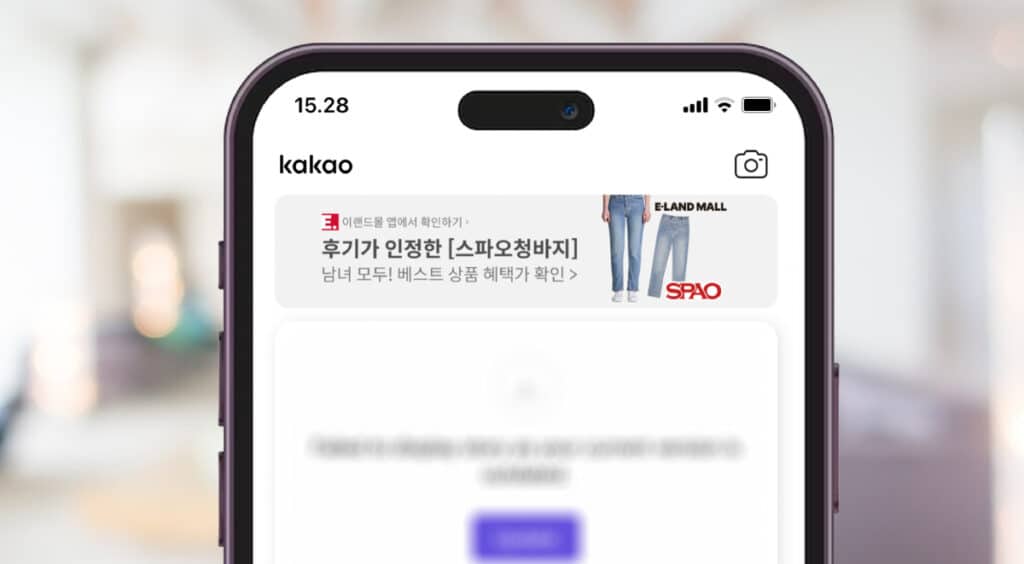
Ad Targeting Options
Targeted advertising takes your digital marketing strategy a step further, enabling you to tailor your ads to a specific audience based on demographics, online behaviors, or interests. Every advertising platform has specific targeting options, allowing you to reach your desired audience. This increases the likelihood of reaching users who are genuinely interested in your services, improving the efficiency of your ad spend. By targeting your ads, you can ensure that your message reaches prospective students who are most likely to be interested in your offerings, making your overall advertising strategy more effective and results-driven.
#5 Influencer Marketing
Influencer marketing involves collaborating with popular figures, or ‘influencers’, who have a substantial following and influence on social media platforms. In the context of South Korea’s education industry, partnering with influencers who resonate with your target audience – primarily students and parents – can bring remarkable results. When these influencers endorse your institution, they help bridge the trust gap between your organization and potential students or their parents. This is due to the trust that followers have in the authenticity and reliability of an influencer’s recommendations.
Moreover, influencers can significantly expand the reach of your institution. With their wide-ranging social media following, a single post about your institution can reach thousands, even millions of people, many of whom might be potential students. This effect is magnified in South Korea, where social media usage is exceptionally high, and influencers wield considerable power.
#6 Email Marketing
Email marketing remains a powerful tool for personalizing your institution’s communication with prospective students. It provides a platform to share a wide array of content, from news and updates about your institution to offerings and course information. By sending personalized emails, you can establish and nurture relationships in a more direct and personal manner. This approach can significantly enhance the engagement and connection your audience feels with your institution, thereby aiding in both attracting new and retaining existing students.
#7 Press Releases and Media
Press releases and media publications serve as influential platforms to build and enhance your institution’s credibility in the education industry. By regularly sharing informative press releases that highlight key milestones, successes, or unique features of your institution, you shine a spotlight on your institution’s progress and expertise. This can help in portraying your institution as a thought leader in the educational sector. Additionally, these releases get picked up by credible media platforms, reinforcing your institution’s standing in the industry and making your institution a more appealing choice for prospective students and parents. In this way, strategic use of press releases and media can significantly bolster your institution’s authority and image in the education industry.
#8 Social Media Marketing
Social media marketing has emerged as a powerful tool for educational institutions to connect with and engage their audience. It provides a dynamic space where you can strike a balance between sharing informative, educational content and lighter, more engaging posts that keep your audience interested and entertained. Active engagement is the key to fostering a sense of community on these platforms. Responding to comments and messages in a timely and thoughtful manner can help build relationships and show your audience that you value their input and participation. Further amplifying your reach, you can leverage a variety of popular platforms, including Facebook, Instagram, Naver Cafe, and Kakao Moments, each offering unique ways to interact with your audience. By adopting this multi-platform approach, you can reach a wider audience and cater to different user preferences, thereby effectively boosting your institution’s social media presence.
Embracing the Future of Digital Marketing in South Korea’s Education Sector

In conclusion, the evolving landscape of South Korea’s education sector emphasizes the critical role of digital marketing in fostering connections with students and parents. This guide has illuminated the necessity of digital marketing in this highly competitive industry and outlined effective strategies such as SEO, content marketing, influencer collaborations, and social media engagement. With the implementation of these modern tools, such as PPC advertising, email marketing, and website optimization, educational institutions can amplify their reach and impact. Embracing these digital marketing strategies is not just about staying current; it is about paving the way for better engagement, improving accessibility, and adopting a student-centric approach—an essential step in securing a firm place in the future of South Korea’s education industry.
Inquivix, as the leading digital marketing agency in South Korea, has the experience and ability to help your education institute establish its presence in this competitive market. We offer comprehensive digital marketing services and customized solutions for your business. You can check out our services on our website or contact us to learn more.
FAQs
The South Korean education market is highly competitive and is growing at a fast pace. It is expected at a growth rate of about 9.15% per year over the next five years, reaching US$124.6 million in 2027.
Engaging a digital marketing agency specifically for South Korea can be an invaluable move for businesses aiming to penetrate this dynamic market. Given the country’s advanced digital landscape and unique consumer behaviors, a local agency brings a deep understanding and expertise about the nuances of the South Korean market. These agencies are well-versed with leading platforms like Naver, Kakao, and more, which are key to reaching and connecting with the South Korean audience. Furthermore, they can deftly navigate the language and cultural subtleties to create campaigns that resonate with local consumers. Ultimately, hiring a digital marketing agency for South Korea can help businesses craft more effective strategies, optimize their resources, and maximize their market potential in the region.
